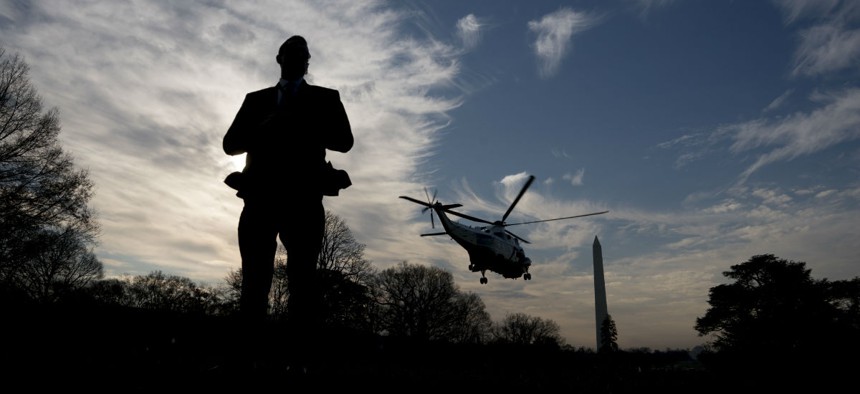
A Secret Service agent stands guard as Marine One leaves the White House. The Secret Service would see a hiring boost under Trump's budget. Andrew Harnik/AP
The Hiring Surges in Trump's Otherwise Cut-Filled Budget
Aside from four agencies, the administration is seeking to cut 42,000 federal workers.
Early in President Trump’s tenure, his administration issued a directive calling on all federal agencies to include long-term plans to reduce their workforces as part of the fiscal 2019 budget proposal. To kick things off, agencies proposed shedding a net total of 10,000 workers that year.
That figure belies much more significant reductions at the vast majority of agencies. Before accounting for gains at the departments of Homeland Security, Commerce, Veterans Affairs and Defense, the Trump administration is planning to cut 42,000 workers from the federal rolls. Also embedded in Trump’s blueprint, however, are significant hiring sprees at those four agencies. So where exactly is the administration envisioning extra employees coming on board?
At DHS, the call to beef up ranks was expected. Trump signed an executive order in January that instructed the department to hire 15,000 new employees. Under the fiscal 2019 proposal, Customs and Border Protection would hire 750 new border agents and an additional 150 support staffers. Immigration and Customs Enforcement is seeking 2,000 new agents and 1,300 support personnel. Actually reaching that target will prove a difficult task, however, as DHS has struggled to meet existing hiring quotas dating back to the Obama administration.
Last year, Border Patrol hiring failed to keep pace with attrition. Congress appropriated CBP resources to hire 2,000 new customs officers in 2014, but 1,200 vacancies still remain. Trump proposed the agency fund relocation and retention incentives, better application processing and other investments to ease hiring next fiscal year. Both CBP and ICE would boost training efforts.
The Secret Service would look to hire 450 special agents and other staff, aiming to get its rolls to 7,600 employees. That would mark a nearly 13 percent boost over current staffing levels and its largest-ever workforce.
“This increase fulfills key recommendations from independent reviews of Secret Service operations, continuing the administration’s progress toward improving the morale of this critical law enforcement agency,” DHS said in its funding request.
The Transportation Security Administration is looking to increase its workforce by nearly 700 employees. DHS would spend $3 million to “support the ongoing implementation of an end-to-end innovative 21st-century personnel ecosystem to ensure the department can recruit, retain and manage top cybersecurity talent.”
Not every DHS component would enjoy a hiring spree. The Federal Air Marshal Service would face attrition and a hiring freeze. The department is looking to add a total of 13,000 employees, an increase of more than 7 percent.
VA has also been struggling to reach its authorized staffing level, and currently maintains about 35,000 vacancies. The department hired a total of 40,000 people in 2017, but due to attrition and turnover the department saw a net gain of just 8,300 employees. It is increasingly relying on expedited hiring authority to onboard medical professionals and other personnel. In fiscal 2019, the Veterans Health Administration is looking to onboard about 6,000 new employees, while the Veterans Benefits Administration would add 800.
The general counsel’s office requested $11 million to hire new lawyers to address an increased workload from a bill Trump signed last year that allowed the department to fire employees more quickly. The department is also looking to onboard more than 200 new fiduciary employees to protect vulnerable veterans. Overall, VA asked to hire 7,000 new employees, a 2 percent increase.
The Commerce Department is seeking the biggest surge in employees over its current workforce, asking for a 21 percent increase, or 9,000 new employees. Those gains would overwhelmingly go toward the Census Bureau as it staffs up for the 2020 decennial survey. Census requested $423 million in additional funding for new hiring, most of which would go toward temporary employees.
“In FY 2019, the 2020 Census will conduct its first major field operation—the in-field address canvassing operation—and thousands of temporary employees will be hired to carry out this crucial final update of the 2020 Census address list,” Commerce said in its request. Census plans to open 40 field offices in January 2019 and an additional 208 by the summer. Critics of Trump’s plan, such as Phil Sparks, spokesman for The Census Project, were quick to note the proposed funding increase for the bureau was less than one-third of what the agency received in 2008.
The Defense Department is looking to boost its end strength military personnel by nearly 26,000 troops. It is aiming to support those personnel with 15,000 new civilian employees in fiscal 2018 and an additional 3,000 employees in fiscal 2019.
“As the department maximizes lethality, improves and sustains readiness, grows the force, and increases capability and capacity,” Defense said in its budget request, “it must improve the overall management of its total force of active and reserve military personnel, government civilian personnel and contracted services.”
Many lawmakers have already declared Trump’s budget “dead on arrival” in Congress, and Office of Management and Budget Director Mick Mulvaney himself acknowledged the proposal was merely a “messaging document.” Last week, however, Trump signed a bipartisan budget deal that massively increased discretionary spending at both domestic and defense agencies. That will likely be good news for agencies looking to boost their ranks, as appropriators now have the room to meet those requests.







